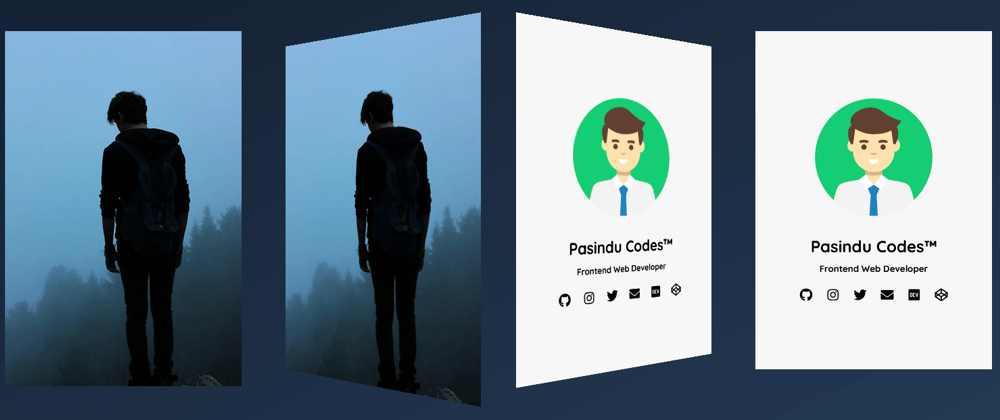In this article we are going to create a 3D Flipping Profile Card Animation with HTML, CSS and little bit of JavaScript. This is a quick preview of what we are going to do today. 😉
So let's take a look at the code...
HTML
<div class="card">
<div class="front">
<img
src="https://data.whicdn.com/images/225797123/original.jpg"
alt="Boy Profile Picture"
/>
</div>
<div class="back">
<div class="text">
<img
src="https://paperads.com/title-img/Assistant-Manager-Admin-&-HR-Jobs.png"
alt="Profile"
/>
<h2>Pasindu Codes™</h2>
<h5>Frontend Web Developer</h5>
<ul>
<li>
<a href="#"><i class="fab fa-github"></i></a>
</li>
<li>
<a href="#"><i class="fab fa-instagram"></i></a>
</li>
<li>
<a href="#"><i class="fab fa-twitter"></i></a>
</li>
<li>
<a href="#"><i class="fas fa-envelope"></i></a>
</li>
<li>
<a href="#"><i class="fab fa-dev"></i></a>
</li>
<li>
<a href="#"><i class="fab fa-codepen"></i></a>
</li>
</ul>
</div>
</div>
</div>
So here is the CSS part.
CSS
@import url("https://fonts.googleapis.com/css2?family=Quicksand:wght@400;500;600;700&display=swap");
* {
box-sizing: border-box;
padding: 0;
margin: 0;
}
body {
width: 100%;
height: 100vh;
display: flex;
align-items: center;
justify-content: center;
background: #141e30;
overflow: hidden;
background: linear-gradient(to left top, #243b55, #141e30);
}
.card {
width: 350px;
height: 500px;
font-family: "Quicksand", sans-serif;
position: relative;
cursor: pointer;
}
.front,
.back {
width: 100%;
height: 100%;
position: absolute;
backface-visibility: hidden;
transition: transform 2s cubic-bezier(0.175, 0.885, 0.32, 1.275);
transform-style: preserve-3d;
}
.front {
transform: perspective(1000px) rotateY(0deg);
}
.back {
background-color: #f7f7f7;
display: flex;
align-items: center;
justify-content: center;
transform: perspective(1000px) rotateY(180deg);
}
img {
width: 100%;
}
.text {
text-align: center;
}
.text img {
width: 200px;
}
.text h5 {
padding-top: 10px;
}
ul {
list-style-type: none;
display: flex;
justify-content: space-between;
padding-top: 10px;
}
ul li a {
display: flex;
align-items: center;
justify-content: center;
text-decoration: none;
color: black;
width: 40px;
height: 40px;
border-radius: 20px;
font-size: 1.2rem;
transition: all 0.2s;
}
ul li a:hover {
background-color: rgb(17, 17, 17);
color: white;
}
.backTurn {
transform: perspective(1000px) rotateY(0);
}
.frontTurn {
transform: perspective(1000px) rotateY(-180deg);
}
This is the final and easiest part. Let's add the click event of the card with some JavaScript.
JAVASCRIPT
const card = document.querySelector(".card");
const front = document.querySelector(".front");
const back = document.querySelector(".back");
card.addEventListener("click", function () {
front.classList.toggle("frontTurn");
back.classList.toggle("backTurn");
});
It's done. 😀. So how was that ? Leave a like if you are interested.
Follow me on Twitter
Thank You :)







Top comments (1)
Cool !!